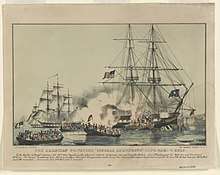HMS Plantagenet (1801)
HMS Plantagenet was a 74-gun third rate ship of the line of the Royal Navy, launched on 22 October 1801 at Woolwich. She was designed by Sir William Rule as one of the 'large class' 74s, and was the only ship built to her draught. As a large 74, she carried 24-pounder guns on her upper gun deck instead of the 18-pounder guns found on the middling and common class 74s.[1]
_(14764138665)_(cropped).jpg) Plantagenet | |
| History | |
|---|---|
| Name: | HMS Plantagenet |
| Ordered: | 6 November 1794 |
| Builder: | Woolwich Dockyard |
| Laid down: | November 1798 |
| Launched: | 22 October 1801 |
| Fate: | Broken up, 1817 |
| General characteristics [1] | |
| Class and type: | 74-gun third rate ship of the line |
| Tons burthen: | 1777 (bm) |
| Length: | 181 ft (55 m) (gundeck) |
| Beam: | 47 ft (14 m) |
| Depth of hold: | 19 ft 9 in (6.02 m) |
| Propulsion: | Sails |
| Sail plan: | Full rigged ship |
| Armament: | |
_(14764138665).jpg)

Career
In 1803 she and Rosario captured the French privateer sloop Atalante, of 22 guns, after a chase of nine hours. The Royal Navy took Atalante into service as Hawk.[2]
In June 1804 Plantagenet, Captain De Courcy, escorted the China Fleet of the British East India Company from Saint Helena back to England. This was the fleet that had scared off a French squadron of warships in the Battle of Pulo Aura.[3]
On 27 September 1810 Plantagenet and Daphne shared in the capture of the Danish schooner Toujours Fidele.[4]
During the War of 1812, as the ship was moored near Norfolk, Virginia, attempts were made to destroy her with torpedoes built to Robert Fulton's specifications, but this came to nothing.[5]
On 16 December 1813, Planagenet's boats captured the American letter of marque schooner Rapid, off Havana. Rapid, Captain James Frazier, had been launched at Talbot County, Maryland in 1813. She was of 115 tons (bm), had a crew of 20, and was armed with one nine-pounder gun.[6][Note 1]
Fate
Plantagenet was broken up in 1817.[1]
Notes, citations, and references
Notes
Citations
- Lavery, Ships of the Line vol.1, p184.
- "No. 15607". The London Gazette. 2 August 1803. p. 963.
- Hardy and Hardy (1811), pp. 119-125.
- "No. 16522". The London Gazette. 14 September 1811. p. 1817.
- ""Yankey Torpedo" Adventures". Retrieved 8 July 2014.
- Cranwell & Crane (1940).
- "No. 17012". The London Gazette. 16 May 1815. p. 927.
References
- Cranwell, John Philips, & William Bowers Crane (1940) Men of marque; a history of private armed vessels out of Baltimore during the War of 1812. (New York, W.W. Norton & Co.).
- Lavery, Brian (2003) The Ship of the Line - Volume 1: The development of the battlefleet 1650-1850. Conway Maritime Press. ISBN 0-85177-252-8.